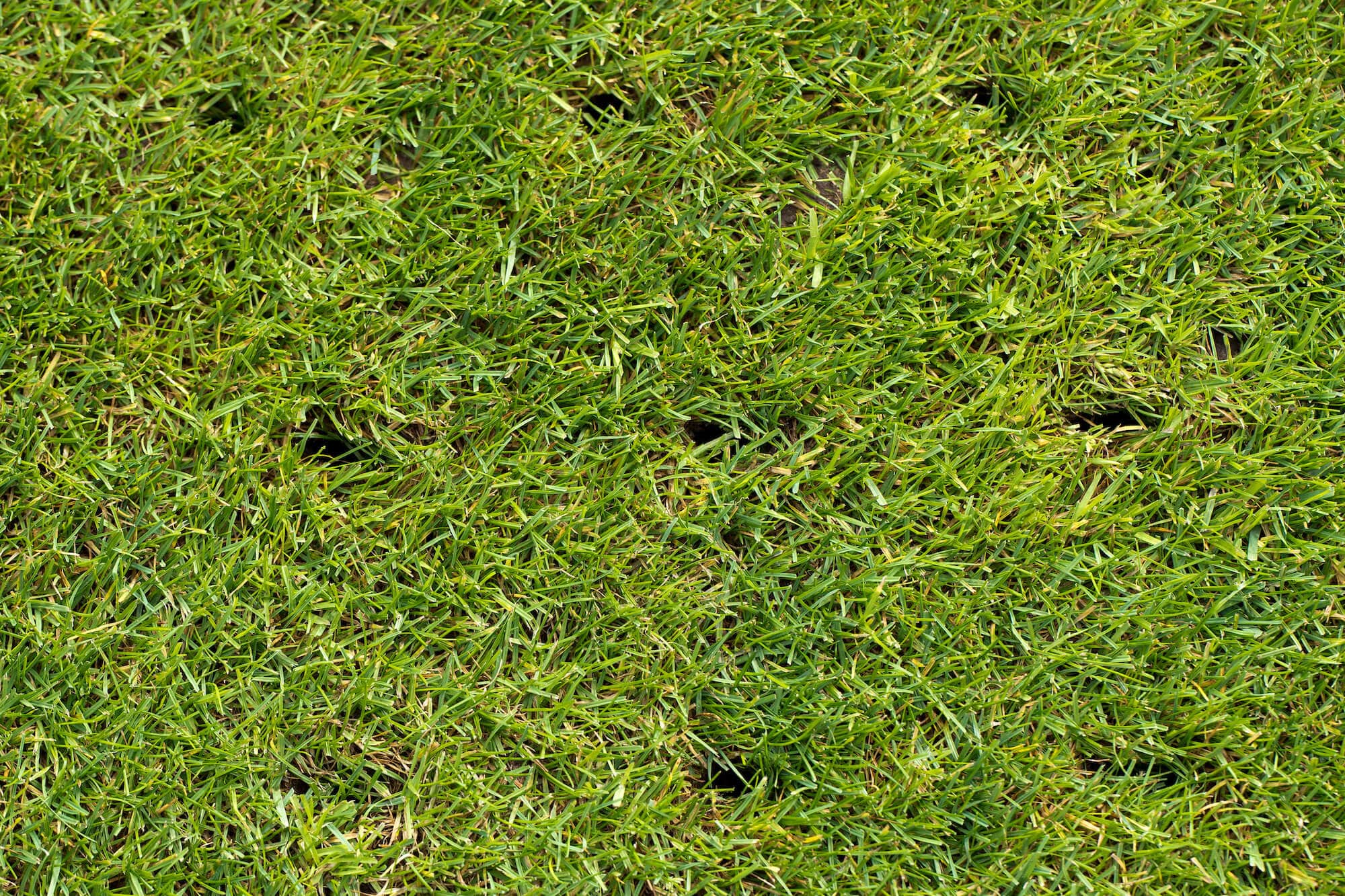Your Detailed Guide to Lawn Aeration
When we think of our annual lawn care regimen, a regular watering and mowing schedule is often what comes to mind. On a basic level, keeping your grass trimmed, tidy, and watered is the key to a healthy lawn.
However, our landscapes go through a lot throughout the year—they’re walked on, inundated with pests and fungus, and have to adapt to the ever-changing seasons. Lawn aeration is one of the most helpful and unsung heroes of keeping your soil—and therefore your grass—healthy and strong.
Aeration is the process of removing small cores or slicing delicately through the top layer of your lawn and soil. By doing so, the resulting soil is less compacted, allowing more water, oxygen, and nutrients to permeate the deeper root laters and keep your grass strong and vibrant.

The Benefits of Lawn Aeration
Cutting holes into your lawn may seem counterintuitive to a healthy landscape, but the method is incredibly common for grass lawns across the country. Landscape experts recommend aerating your lawn right before the peak of your grass’s growing season or when you’re experiencing ongoing issues.
Think of your lawn a bit like any other floor or walking surface around your home. Everything from foot traffic to decor and construction equipment presses down on the ground, slowly causing the soil to become more dense. This is particularly true for soils with a high clay content. Without enough space for air and water to flow freely, nutrients become cut off from the grass’s roots.
The main benefits of lawn aeration include:
- Increased drainage across your lawn
- Greater access to water, air, and sunlight to the grass roots
- Strengthens roots and opens up soil for foot traffic
- Fights against erosion
- Protects against effects of drought or flooding
- Decreases weed growth
Aeration’s Fight Against Thatch
Lawn aeration also protects against the overgrowth of thatch—the dense layer of roots and other organic material between the grass and the soil. This layer is normal, and even helpful for the health of your grass, but an imbalance could send your thatch growing too thick.
Similar to dense soil, overly thick thatch means that air, nutrients, and water cannot reach the depths necessary to grow and maintain healthy grasses.
6 Signs It is Time to Aerate Your Lawn
Of all the issues we encounter while keeping our lawns healthy, many of them stem from a lack of circulation in the soil or unhealthy grass.
Here are the top reasons and time to consider aerating your lawn.
1. It’s the Start of the Season
For both cool and warm-season grasses, experts recommend aerating your soil just before the highest growth period of your variety of grass. For example, cool-season grasses are often aerated in the early spring while warm-season ones wait a bit longer.
Annual or semi-annual aeration helps break up the soil after the effects of a long winter covered in snow, leaves, and ice.
2. It’s Time for Fall Overseeding
If you prefer to overseed your lawn before the season wraps up, performing aeration just before the process can help the soil accept the seed more evenly. Even if you are not overseeding, some cool-season grasses can be aerated for standard care in the fall if it didn’t happen in the spring.
3. You have Dense Clay Soil
Highly humid and tropical regions are more likely to feature a large clay content in home lawns. If this is the case, be sure to aerate your lawn at least every 2-3 years. If you experience any of the issues below, aeration may be the key to breaking up the ultra-dense clay soil.
4. You Have Puddles or Flooding in Your Lawn
Your lawn should provide a natural system for allowing water to flow away from your house and deep into the group. A dense top layer of soil can keep this from happening, leading to pools of what that encourage pests and fungus.
5. Your Soil Just Experienced Extra Traffic
Everything from hosting a large party in your backyard to finishing up some home construction can highly compact your lawn’s soil. If you detect issues with your lawn after a large project, plan an aeration to encourage regrowth.
6. There Are Brown Spots in Your Lawn
If water and air are unable to circulate through specific areas of your lawn, you may end up with uneven coloring across your grass. Pooled water and moisture can even lead to the growth of fungus, many of which break down your grass’s health leading to brown spots.
How and When to Aerate Your Lawn
As you’ll see below, there are several approaches to aerating your lawn, some of which are more time consuming than others. With the proper equipment, aeration can take as little time as mowing. However, since these tools can be pricey, hiring a professional team like TruGreen is often far more cost-effective in the long run.
The aeration process is highly beneficial to your lawn when it is applied at the right moment. You can over-aerate, especially if you are not experiencing issues with dense soil. Stick to once a year when you’re having issues or every other year if not.
Before you begin, be sure your lawn meets the right conditions for maximum results.
Check Your Moisture Level
Try to aerate your lawn when its level of moisture is most balanced. If the soil is too wet, it will simply break apart when aerated. Too dry, especially after a drought, and it could damage the soil too severely.
Wait to aerate your lawn about a day after rainfall or a significant watering.
Check Your Thatch
Dethatching your lawn will help the core aerator or space connect directly with the soil below your grass. This is also a good time to inspect your lawn for issues like an overgrown thatch that could be stemming from a larger issue.
Delicately dig out a small cross-section of your lawn, just a few inches wide if possible. Measure the thick layer of roots between the soil and the grass. If the layer measures beyond a half an inch, it is important to focus on dethatching before aeration.
Use a dethatching rake to remove any extra thatch and make way for the aerator.
Choose the Right Tools
There is a long list of options when choosing a lawn aeration system, but not each one is best for each lawn. We’ve included a rundown of how to pick the right aeration tool for you.
Spike vs. Core Aerator
You’ll likely come across two types of aerators on the market both in the handheld and electric categories.
Spike aerators are just as they sound. In this case, blades pierce the earth, adding thin slices to the ground without removing any significant portions of soil. While this option may appear less invasive, it can actually cause more harm than good. The small holes are easily pushed back into place, defeating the purpose of your efforts.
Core—or plug aerators, remove individual pieces of your lawn in small pieces. The process allows the water and air direct access to the roots and holds up longer than a spike aerator.
Garden Fork Aerators
If you’re working with a very small yard or want to stick to a strict budget, this simple and classic route will do the trick. A garden fork presses down into the lawn in even intervals, carrying the core of soil with it.
Push Aerator
The next step up is the push aerator, which looks a bit like a combination of an old-fashioned and vertical mower. This mechanical process allows you to delicately maneuver a small-to-medium-sized lawn at your own pace.
If you have an oddly shaped landscape or objects to avoid—such as sprinklers or decor—this may be the best option.
Aeration Shoes
You can even purchase shoe attachments made for a simpler aeration process. These adaptable soles attach to the bottom of your shoes. Several-inch spikes jut out for the bottom, removing small cores as you walk.
While this option is more cost-efficient—typically between $20 and $30—it can be time-consuming and harder to measure.
Core Aerating Machines
The quickest and most effective aerator for large properties is the automatic core aerating machine. These tools either come on their own or as an attachment to your riding mower. Similar to the manual options, a set of rotating spikes remove a two-to-three-inch core of soil as it passes over the lawn.
These machines can either be purchased or rented at your local hardware and landscape store. If you have a large lawn and hope to avoid renting large machinery, speak to your local TruGreen team about our aeration services.
Prepping Your Lawn for Aeration
It is important to have a flat and clear lawn before aerating—especially if you plan to use a motorized machine. Before you begin:
- Ensure the lawn’s moisture is balanced for aeration.
- Use a dethatching rake to remove excess thatch.
- Clear away material removed during dethatching to ensure an even working space.
- Double-check the area for any large sticks, rocks, or loose lawn decor items.
- Map out your lawn, noting any hoses, sprinklers, or hard-to-maneuver areas.
Post-Aeration Tips
Whether you go the manual or automatic route, you should be left with small plugs of soil and grass across your lawn. There is no harm in leaving these on your lawn to decompose.
Depending on your lawn’s needs, here are some necessary steps after the aeration process:
- Fertilize: The open sections of lawn are prime for sending fertilizer right to open roots on your grass. This is particularly helpful at the start of the season before the weather hits its peak temperature.
- Overseed: If you’re experienced thin or patchy grass, overseed just after aerating your lawn. Many homeowners specifically aerate their lawn with the intention of overseeding more efficiently.
- Water: Add an even layer of water to your lawn after you’ve completed aerating, overseeding, or fertilizing. Be sure to avoid overwatering to keep the newly cut soil from eroding.
In the first week after aeration, try to cut down on foot traffic as much as possible. This will allow seeds and fertilizer to properly sink into the soil without becoming accidentally compacted too quickly.
TruGreen Aeration Services
Proper aeration is best when you have the assessment of a professional eye. Timing out the process correctly as well as choosing the right tools for your lawn can be daunting for beginners and seasoned homeowners alike.
The TruGreen team uses today’s most advanced tools to remove thatch, aerate your lawn, and monitor its progress as it becomes the lush landscape you deserve. When you work with a TruGreen specialist, you can expect to receive:
- A customized lawn care plan for your unique home
- Recommendations of fertilization and overseeding specific to your region and soil
- Complete analysis of your lawn’s health
- Professional care that works within your budget and schedule
Aeration is a common process that should become a part of your annual regimen. Reach out for a free aeration estimate today to hear how TruGreen can help keep your lawn strong and healthy without the stress.







